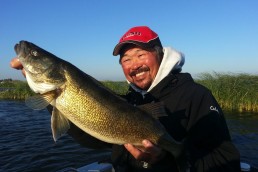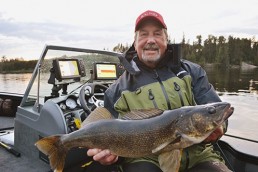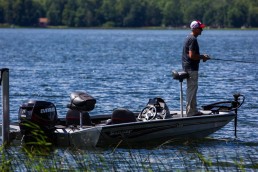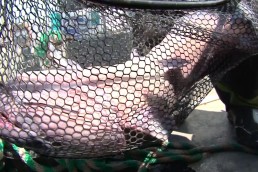Fish Like Edges
SHARE THIS POST
It’s critical to think about an important piece of angling wisdom: recognize the importance of edges.
Just like all types of wild game, fish of all kinds, including walleyes, love edges for exactly the same reasons as their counterparts on solid ground. The main issue any angler faces is so much water, and so little time. But those who know what edges to look for can quickly focus on the 10 percent of water that holds 90 percent of the walleyes on any given day. The keys to success are recognizing different types of edges, anticipating walleye movements along them based on seasonal and daily conditions and knowing what tactics are best to target them with once their position on the edges is discovered.
Getting edgy
It all starts with the basics: fish travel through any water system from deep water to the shallows to feed or spawn along well-defined features along the bottom. They hold along subtle variations within the drops in depth called “breaks” along the way.
Think for a minute what that means to you on the lakes you fish. It’s easy to see why the old river channel is so important when fishing reservoirs like Lake Francis Case in South Dakota. The channel features the deepest water in the impoundment and its former banks provide the contours by which fish migrate. Add a structural, underwater point that reaches from the shoreline to the channel and walleyes have all they need—a way to travel through the system and a path to shallow water to feed and back.
Anglers on prairie reservoirs will pitch jigs to shallow shoreline points in spring and troll bottom bouncers and crankbaits along the contours at other times of the year. Sometimes the contour is at 10 feet while at others it’s the deeper breaks, but it’s always on the edge.
Don’t expect all edges to be pronounced, as some are quite subtle. Lake Erie’s bottom is essentially featureless for miles, so a break of a foot or two can mean a lot. Walleyes know where these are at and use them.
Variety of edges
Structural edges are only part of the big picture. For example, structure in rivers is critical because it creates another kind of contrast, the current edges between fast and slack water. Rivers feature many of these, also known as eddies. Current edges will form in front and behind obstructions, whether man-made or natural. These current breaks include holes in the river bottom, points, downed trees, wing dams, bridge abutments, and so on.
Current also plays a role where feeder-rivers empty into reservoirs and natural lakes especially during the spring and fall when walleyes are drawn to moving water. Try 3/8-ounce jigs tipped with shiners at places like the mouth of the Menominee River on Green Bay or the Rainy River up in Minnesota. Vertically jig and slip with the current while using your trolling motor or anchor on the old river channels, which serve as their highways.
Walleyes also gravitate toward edges between hard and soft bottoms because different kinds of aquatic creatures inhabit such areas. Transition spots provide a smorgasbord as a result. Subtle changes on the breakline or small rock piles will concentrate fish too.
Are you enjoying this post?
You can be among the first to get the latest info on where to go, what to use and how to use it!
Lake Winnebago is a classic example where weed edges are critical. Most anglers know enough to concentrate on outside weedlines, but they often overlook three other important weed-related edges: the inside weed line, the edge created by the tops of the weeds and the edges surrounding pockets and alleys in vegetation. Each weed edge can be just as important as the others.
Try drifting with the wind or troll with your electric trolling motor using a spinner and split shot or a bullet sinker over weed tops. But remember, weed beds can be massive. Just as you did with the outside and inside weed edges, narrow the search by focusing on the something “different.” Walleyes often hold where a small patch of plants in the bed rise above the others, like tall cabbage rising from a bed of coontail. Walleyes will often be in the cabbage in big numbers.
Toss a marker buoy or enter a GPS waypoint when a walleye strikes so the spot can be found again. Then try targeting the pinpointed area with slip-bobber rigs. Some species of aquatic plants prefer softer bottoms while others prefer a harder bottom of small gravel and sand. Look for places where two types of weeds border one another, thus another form of an edge.
Other kinds of cover have edges, too. Anglers on the Dakotas’ and Nebraska’s reservoirs have been targeting vast forests of submerged trees. Tournaments have been won trolling crankbaits on leadcore deep enough to just tick the upper branches. They also find the points in the treelines, anchor above them and vertically jig or use slip bobbers. Even rocky, sandy or soft-bottomed flats feature edges. On Mille Lacs, fishermen use live-bait rigs or bottom bouncers and spinner rigs to target the little points within their irregularly shaped outlines. Again, it’s that “different” location that can yield results.
Good sonar units are mandatory to find the spot on a spot. All models help identify the edges of structure, cover and transitions between hard and soft bottoms below the boat. Recent advances like Humminbird’s Side-Imaging can paint a visual picture of the bottom out to the sides that is detailed enough to see weeds, rocks and wood and how they’re positioned on breaks.
Think, think, think
More subtle edges are often ignored. Water clarity is an important edge in walleye fishing too, as these fish cannot eat what they cannot see. After rainstorms, runoff from rocky terrain is often cleaner than the main river, so fishing the mouths of feeder creeks where there is clean water makes sense. Where runoff comes from farm fields, the main lake may be clearer. Either way, places where dirty water and cleaner water meet will often attract fish.
Wind blowing into a point onshore can create a mud line where walleyes feast on confused baitfish. The wind works to an angler’s advantage where you are less likely to spook shallow predators. There have been many times on reservoirs like Oahe when windy shorelines produced as long as the breeze was blowing, but the action stopped when the wind changed direction. This is an example when it’s time to move on to the windy side.
Each type of edge is important in its own right, but experience has taught us that the more types of edges that are combined, the more likely the walleyes are there.
So, who needs an edge? We all do.
MWO
SHARE THIS POST
Did you enjoy this post?
You can be among the first to get the latest info on where to go, what to use and how to use it!
Ted Takasaki
Ted Takasaki is an International Fishing Hall of Fame professional angler who has been featured in many national outdoor magazines and television shows. Takasaki has appeared in front of thousands of angling enthusiasts and is considered one of America’s top walleye and multispecies anglers. Follow him on his Facebook page.



